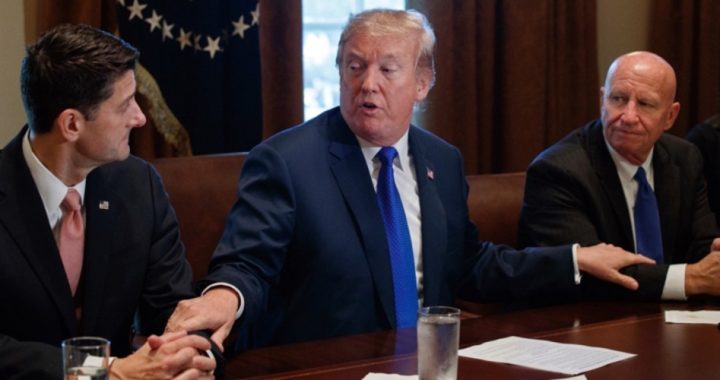
The GOP tax reform bill presented last Thursday attempts to be “revenue neutral” within 10 years. By giving most of the cuts to corporate taxpayers, there’s precious little left for the middle class to enjoy. The problem is not only the mathematics — trying to match the “give” with the “take” — but the politics: Democrats will work to scuttle any attempt to relieve fiscal pressure on entrepreneurs (i.e., capitalists) who are largely carrying the burden of supporting the government. Absent any attempt to cut spending — the tax bill’s 429 pages offer little help with that — what’s left, as has been said, is simply moving the chairs around on the deck of the Titanic.
First, the bill appears to offer three tax brackets instead of seven: 12 percent, 25 percent and 35 percent. But those on the lowest steps of the income ladder technically won’t pay anything, as nearly half of working Americans don’t pay any net federal income taxes because they receive more in government benefits or refunds than they pay in, so they effectively are in a “zero-percent” tax bracket. And the GOP has acceded to demands by Democrats to leave the present highest tax bracket alone: 39.6 percent. So that essentially makes five brackets.
But wait, there’s more! The day after the GOP plan was rolled out, House Ways and Means Committee Chairman Kevin Brady (R-Texas) added a “bubble tax” for those with incomes over $1 million a year. That brings the 39.6 percent bracket to 46 percent and change. So that’s six brackets, down from the current seven.
Of course, typical of how Washington works, what the GOP presented on Thursday will look nothing at all like what is finally passed by the House, and that will look little like what the Senate, and the conference committees following, will present to President Trump for signing.
Even the mildly supportive Wall Street Journal expressed its editorial disappointment: “The [GOP] draft is … a much-needed pro-growth reform of business taxes marred by a mess on individual taxes that makes that part of the code even worse that it is now.”
A quick look at the mess confirms the Journal’s opinion:
• The top corporate rate would be cut from 35 percent to 20 percent;
• Corporations would pay income taxes on a “territorial” basis: taxes to be levied where the income is earned;
• Corporate profits already earned and stashed overseas would be allowed back into the U.S. at 12 percent;
• Corporations would be allowed to deduct “expense” capital investments in the year they are made, avoiding the paperwork and disincentives involved in expensing them over time;
• The rate on “pass-through” businesses — sole proprietorships, partnerships, etc. — would drop to 25 percent from 39.6 percent, and
• The estate tax would be phased out over six years while the present exclusion would double to $10 million.
Many individual taxpayers might pay less overall, but the net effect after taking into account the eliminating or cutting back of various deductions is likely to be minuscule. Student loans would no longer be deductible, the medical expense deduction would be eliminated altogether, alimony payments and moving expenses would no longer be deductible, and the odious ObamaCare “mandate” would remain in place. As Donald Jeffries noted at LewRockwell.com: “On the surface, it looks as if some lower-wage earners will get a tax break, but this must be juxtaposed against the elimination of most of the deductions they once benefitted from. For most of us, there will be a minimal difference, if any at all. Any slight lowering of the tax rate will at least by countered by the loss of deductions.”
And the hunt is on for any additional sources of revenue that might have previously been overlooked. The “bubble tax” mentioned above could raise more than $50 billion over the next 10 years. The COLA (Cost Of Living Adjustment) on the tax brackets just offered by Brady on Friday would apply immediately instead of waiting until 2023. Thus “bracket creep” thanks to inflation (thanks to the Federal Reserve) will push lower income taxpayers into higher brackets, which would generate another $89 billion in 10 years.
But how about this for increasing revenue: Eliminating ObamaCare subsidies would save $416 billion over the next decade, but political pressure from Democrats (and their constituents who are enjoying coverages at below-market rates) is likely to torpedo any such elimination. And there’s the estimated $23 billion to $71 billion that illegal immigrants are enjoying by gaming the welfare system. As Luke Messer (R-Ind.) noted, quoting a study done by a local news team, “Illegal immigrants were claiming the [Child Tax Credit] for children and other relatives who didn’t even live in the United States, sometimes claiming up to 10 or 12 dependents at a time.” The inspector general has repeatedly urged the IRS to stop making these payments, but the agency has refused, claiming that it interprets the law to cover illegals as well as other taxpayers.
The sausage-making begins today as Brady’s committee begins marking up the bill. On Thursday, Representative Brady and House Speaker Paul Ryan (R-Wis.) are scheduled to review it with the president before sending it to the House floor for a vote. The goal is to have the House vote on it before Thanksgiving, just 18 days from now.
Photo of House Speaker Paul Ryan (left) and Representative Kevin Brady (right) meeting with President Trump on November 2: AP Images
An Ivy League graduate and former investment advisor, Bob is a regular contributor to The New American magazine and blogs frequently at LightFromTheRight.com, primarily on economics and politics. He can be reached at [email protected].



